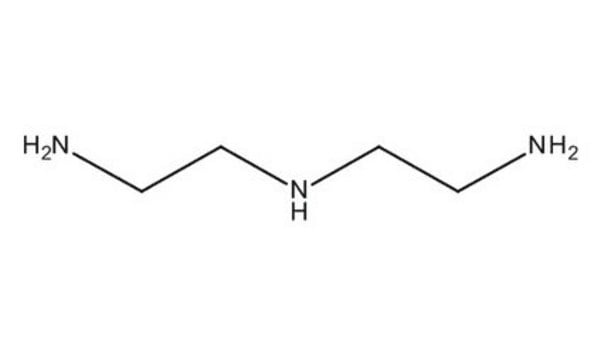If this product has an expiration or retest date, it will be shown on the Certificate of Analysis (COA, CofA). If there is no retest or expiration date listed on the product's COA, we do not have suitable stability data to determine a shelf life. For these products, the only date on the COA will be the release date; a retest, expiration, or use-by-date will not be displayed.
For all products, we recommend handling per defined conditions as printed in our product literature and website product descriptions. We recommend that products should be routinely inspected by customers to ensure they perform as expected.
For products without retest or expiration dates, our standard warranty of 1 year from the date of shipment is applicable.
For more information, please refer to the Product Dating Information document: https://www.sigmaaldrich.com/deepweb/assets/sigmaaldrich/marketing/global/documents/449/386/product-dating-information-mk.pdf
T11509
Tetraethylenepentamine
technical grade
Synonym(s):
TEPA, Tetrene
Select a Size
Select a Size
About This Item
Recommended Products
grade
technical grade
Quality Level
vapor density
6.53 (vs air)
vapor pressure
<0.01 mmHg ( 20 °C)
assay
≥30%
form
viscous liquid
autoignition temp.
610 °F
refractive index
n20/D 1.505 (lit.)
bp
340 °C
mp
−40 °C (lit.)
density
0.998 g/mL at 25 °C (lit.)
SMILES string
NCCNCCNCCNCCN
InChI
1S/C8H23N5/c9-1-3-11-5-7-13-8-6-12-4-2-10/h11-13H,1-10H2
InChI key
FAGUFWYHJQFNRV-UHFFFAOYSA-N
Looking for similar products? Visit Product Comparison Guide
Related Categories
General description
Application
- To functionalize magnesium 2,5-dihydroxyterephthalate (Mg-MOF-74) to enhance the CO2 adsorption performance of the material.
- To modify magnetic chitosan resin to form amine-bearing chitosan for the efficient removal of uranium from an aqueous solution.
- To synthesize poly(vinyl-chloride)/tetraethylenepentamine (PVC-TEPA) composite material, which is used as an efficient catalyst for the Knoevenagel condensation reaction.
signalword
Danger
Hazard Classifications
Acute Tox. 4 Dermal - Acute Tox. 4 Oral - Aquatic Chronic 2 - Eye Dam. 1 - Skin Corr. 1B - Skin Sens. 1
Storage Class
8A - Combustible corrosive hazardous materials
wgk_germany
WGK 2
flash_point_f
325.4 °F - closed cup
flash_point_c
163 °C - closed cup
ppe
Faceshields, Gloves, Goggles, type ABEK (EN14387) respirator filter
Choose from one of the most recent versions:
Already Own This Product?
Find documentation for the products that you have recently purchased in the Document Library.
Customers Also Viewed
-
How can I determine the shelf life / expiration / retest date of this product?
1 answer-
Helpful?
-
-
How is shipping temperature determined? And how is it related to the product storage temperature?
1 answer-
Products may be shipped at a different temperature than the recommended long-term storage temperature. If the product quality is sensitive to short-term exposure to conditions other than the recommended long-term storage, it will be shipped on wet or dry-ice. If the product quality is NOT affected by short-term exposure to conditions other than the recommended long-term storage, it will be shipped at ambient temperature. As shipping routes are configured for minimum transit times, shipping at ambient temperature helps control shipping costs for our customers. For more information, please refer to the Storage and Transport Conditions document: https://www.sigmaaldrich.com/deepweb/assets/sigmaaldrich/marketing/global/documents/316/622/storage-transport-conditions-mk.pdf
Helpful?
-
Active Filters
Our team of scientists has experience in all areas of research including Life Science, Material Science, Chemical Synthesis, Chromatography, Analytical and many others.
Contact Technical Service



















